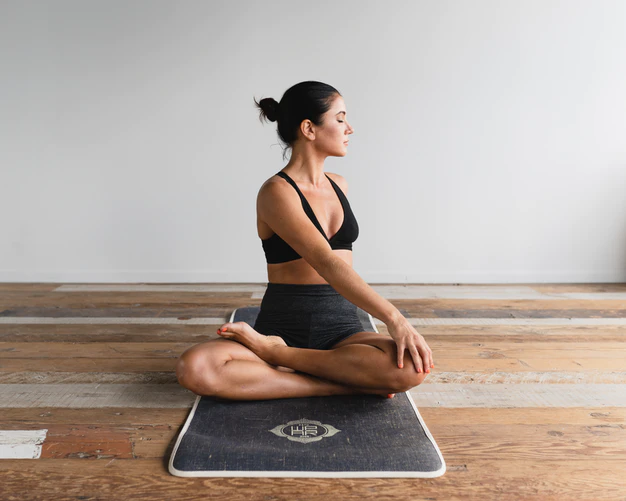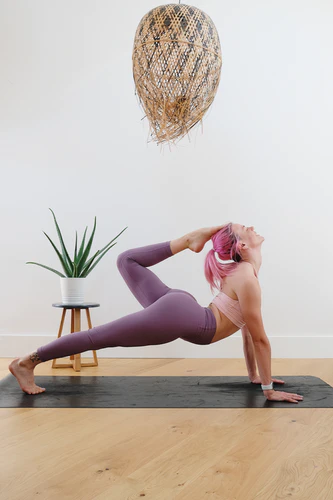Last Updated on October 26, 2022 by admin
Since the global Covid-19 pandemic has started, many people have leaned towards taking up new hobbies and channeling their inner creativity. For some, this includes wanting to start or beginning to learn how to do yoga.
Yoga is a wonderful activity that connects the mind and body while simultaneously relaxing, stretching, and working out your muscles. It has plenty of benefits for both and women of all ages and sizes. If you are a yoga beginner, you might still be working on creating a schedule or yoga routine that works around the rest of your busy day.
You might even be on a temporary working from home schedule or at home and in the office, which can make it tricky to plan things around so you can still get your yoga workout in.
Some people like practicing yoga in the morning, during the day, or at night. No matter what time of day you choose to participate, if you put the effort in, you will experience results. How much or how little you do yoga differs for each and every person.
In the beginning stages, you may only feel comfortable enough doing one or two yoga sessions per week. This is the normal amount that people typically start out with, and then they see how they feel going forward after a few times. It is difficult to know exactly, but how often should you do yoga?
Once you start to feel more confident with the stretches and poses, you can move to more advanced stretches or aim for three or four sessions in a week. Everyone runs on a different daily schedule, so everyone’s yoga schedule will also be different and unique. Today we are going to discuss creating your yoga schedule and what should you consider when you are planning your yoga time:
Set Goals
Talking about yoga and picking out your yoga mat and accessories is the easy part of creating your yoga schedule. Sometimes the hardest part is just getting the motivation to get your yoga mat out and begin. It can be hard in the morning when you are just waking up and want to relax with a cup of coffee, or after a long day of work and you want to sit on the couch and chill out.
The biggest thing to remember when you create your schedule and yoga routine is not to get down on yourself too hard if you miss a day of yoga. Life happens, and goals are not achieved overnight. If you need to adjust the days you do yoga, if your work schedule is constantly changing, that will work just fine.
Although it is okay to miss a day or two here and there of yoga practice and exercise, it is a smart idea to sit down and set weekly or monthly goals to help keep you on track. Your goals can be as small or big as you personally feel you can achieve.
You don’t have to dedicate long hours every day or strive to achieve a highly advanced stretch to achieve your goals either. Your yoga goals will be personal depending on your body and fitness, what you would ideally like to get out of yoga, and what your average day looks like.
Once you begin to figure out what days and stretches work best for you, you can begin to create a schedule, and doing this will determine your goals. It is a good idea to write down your schedule and goals because it will engrain in your memory better and you have a reference if you were to forget or become lazy.

Listen To Your Body
The two big parts of you that yoga uses are your mind and your body. Listening to your body is extremely important when it comes to doing yoga. Certain poses and stretches can result in serious injuries if you don’t have the skill or strength to perform them properly.
If you feel sore from a yoga workout or just feel like your body could use some rest, listen to yourself and take a break. Overworking your body and stretching to uncomfortable positions and yoga postures is not what a yoga session is about. It is there to calm your mind and help release tension and soreness in the muscles, not harm them.
The same point of listening to your body can go both ways. If you feel like after a few weeks, your body is becoming stronger and more flexible, you can increase your schedule to three or four times a week rather than one or two. It is all about body awareness.
If the poses and stretches are becoming too easy and you need more of a challenge for your yoga workout, take on a harder pose or practice more challenging yoga moves. Your body and mind need to constantly communicate with each other to produce the best results from doing yoga.
Once you listen to your body and know how to hear what it is telling you, creating and following your yoga schedule will become easier and easier. Getting your body into the habit of doing it is half the battle.
How Is Your Mental State of Mind?
Like we previously mentioned, two big parts of you that yoga requires are your mind and body. Listening to your body is very important, but so is your brain. Checking in with yourself daily is important, so you don’t become overworked and mentally burnt out. Our mental health is key to living a happy, healthy life.
Yoga can help us with that, calming and relaxing our mind and helping us forget about unwanted, intrusive thoughts. Focusing on your breathing technique and taking that quiet time for yourself can make all the difference in our mental state. The world is so busy and always moving, it is extremely important to take the time to care for your body and brain.
However, there are always times where even yoga can’t help us get out of our dark place. Recognizing this and taking in how you are feeling is a great first step. If you feel mentally exhausted and taking a nap is ultimately what you need instead of getting into fitness clothes and stretching, that is one hundred percent okay.
Your yoga schedule can be flexible and should consider how you feel mentally and physically. If you are mentally and physically drained and not interested in what is going on, your yoga will not benefit you.

Everybody Is Different
Everyone’s yoga schedule is going to be different. We all have different jobs that run at different times of the day. If you are a night shift person, maybe doing yoga before going into your shift would be the best time for you.
If you work the general nine to five hours, yoga in the morning before work or before bed are both great times. How long you will be able to do your yoga also will vary from person to person. Half an hour yoga sessions can be just as beneficial as a two-hour session, as long as you put your effort and attention into the session.
Your schedule will also look different depending on if you choose to sign up for a yoga class that you have to drive to in a designated place. You will have to take into account the time it takes to get there and back and that it will be a set time length for the majority of classes.
At-home yoga requires no driving back and forth and the freedom to decide how long or short your session will be. You can find tons of online yoga videos and tutorials to follow of all different lengths and difficulty. Both at home and designated yoga classes are both great ways to participate.
What Is the Right Answer?
How often should you do yoga? It is important to remember there is no right or wrong yoga schedule, especially for a yoga beginner. Every aspect of daily practice can look different for every person, and that is part of the beauty of yoga. Each person’s schedule and how often they choose to practice yoga will be unique. It is all about listening to your mind and body and taking the time to write down your goals.
It will be different depending on your work schedule if you do regular yoga practice at home or in an actual class with a yoga instructor and what you want to get out of doing yoga. Taking the time to check in with yourself and see how your doing mentally will also lead to a more effective yoga time.
It’s important to remember not to be hard on yourself during your yoga journey if you had planned a session one morning and can’t seem to get on the mat. Everyone has days where all they want to do is lay in bed. As long as you are putting the effort and focus into your daily practice and yoga sessions, you will feel the mental and physical benefit after just one time.

